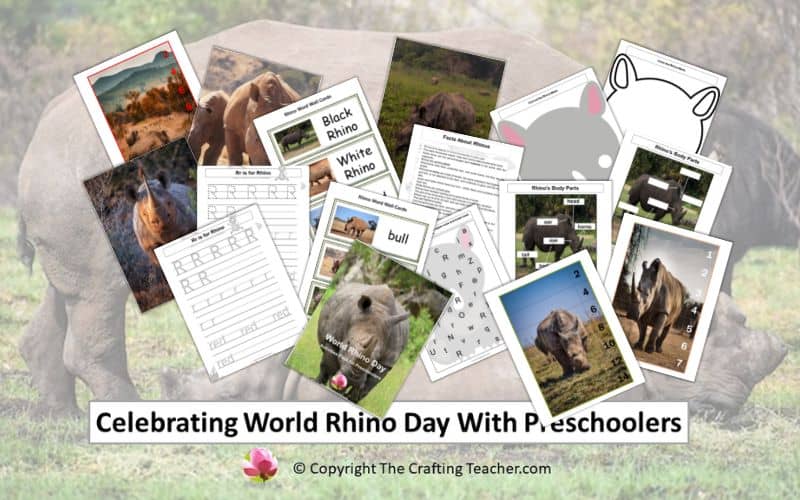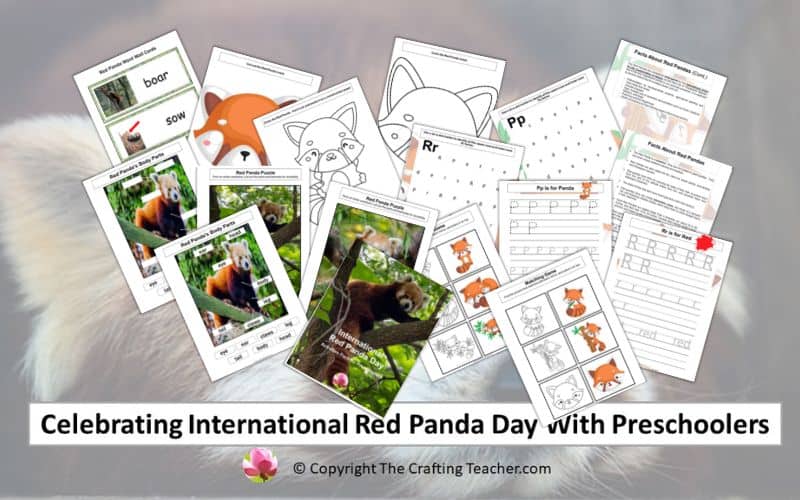Celebrating International Leopard Day With Preschoolers
Affiliate Disclosure: “This post contains affiliate links, which means I receive a small commission, at no extra cost to you, if you make a purchase using those links.”
International Leopard Day is celebrated on May 3rd, to raise global awareness about the ecological importance and the danger of extinction these amazing cats are facing, and to encourage people to become participants in the efforts that conservationists are making to protect these animals and ensure their survival.
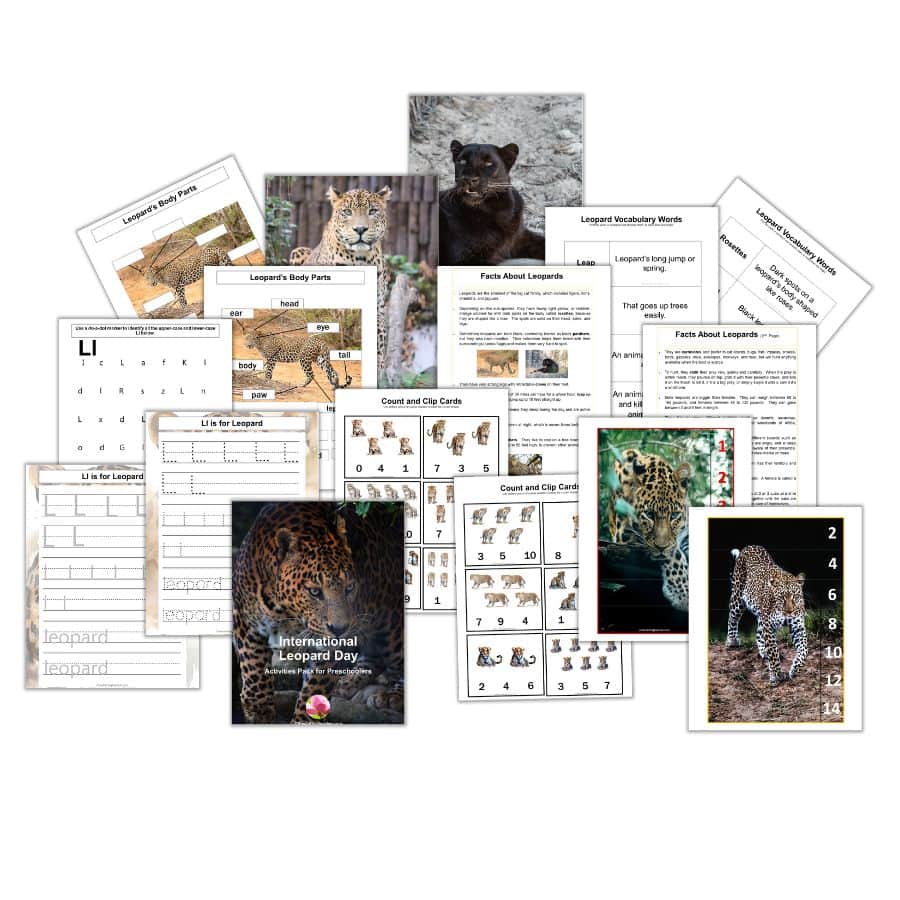
At the end, you will find a free 27-page long International Leopard Day pack, as my gift to you for taking your time and reading this post.
History of International Leopard Day
International Leopard Day started in 2023, with a Global Leopard Conference, with the participation of hundreds of conservationists, scientists, students, and other wildlife advocates, to raise global attention to the leopards, one of the most threatened species in the world.
All the presentations and discussions done during this important conference highlighted the great need to increase awareness across the planet to raise support and funds to protect the leopards. As a result, International Leopard Day was officially born and included in the global wildlife conservation calendar.
Today, with conservation laws such as the U.S. Endangered Species Act and the Commission on International Trade, conservation groups, researchers, and wildlife parks are working hard with local communities to designate protected national parks, reserves, and wildlife corridors for leopards. They are also forming partnerships with local communities and law enforcement agencies to stop illegal hunting and trade, restore habitats, and collect data about the leopard’s life and behavior.
Facts About Leopards
- Leopards are the smallest of the big cat family, which includes tigers, lions, cheetahs, and jaguars.
- Depending on the sub-species, they have tawny light yellow, or reddish-orange colored fur with dark spots on the body called rosettes, because they are shaped like a rose. The spots are solid on their head, sides, and legs.
- Sometimes leopards are born black, commonly known as black panthers, but they also have rosettes. Their coloration helps them blend with their surroundings (camouflage) and makes them very hard to spot.
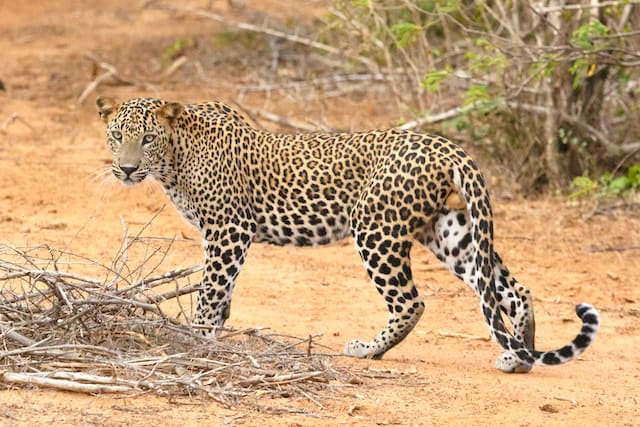
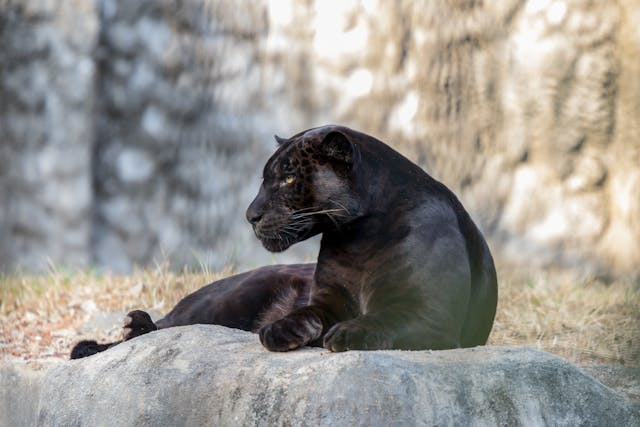
- They have very strong legs with retractable claws on their feet.
- They can run at a top speed of 36 miles per hour for a whole hour, leap up to 20 feet in one bound, and jump up to 10 feet straight up.
- They are nocturnal, which means they sleep during the day and are active at night.
- They have excellent vision, even at night, which is seven times better than humans.
- Leopards are powerful climbers. They like to rest on a tree branch and stash their prey on a tree, up to 50 feet high, to prevent other animals from taking it from them.
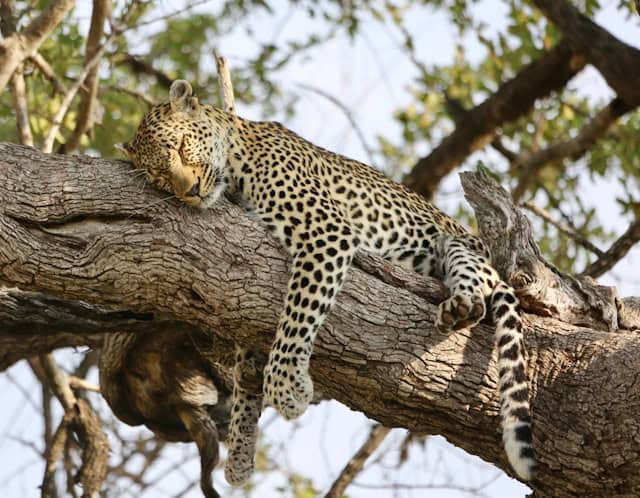
- They are carnivores and prefer to eat lizards, bugs, fish, impalas, snakes, birds, gazelles, mice, antelopes, monkeys, and deer, but will hunt anything available when the food is scarce.
- To hunt, they stalk their prey very quietly and carefully. When the prey is within reach, they pounce on top, grab it with their powerful claws, and bite it on the throat to kill it, if it is a big prey, or simply swipe it with a paw if it’s a small one.
- Male leopards are bigger than females. They can weigh between 80 to 165 pounds, and females between 46 to 132 pounds. They can grow between 3 and 6 feet in length.
- They live in many different habitats, such as deserts, savannas, grasslands, mountains, rainforests, forests, and woodlands of Africa, the Middle East, Russia, Asia, India, and China.
- Leopards communicate with each other using different sounds such as purring when they are happy, growling when they are angry, and a raspy cough when they want to make another leopard aware of their presence. They also mark their territory with urine, feces, and claw marks on trees.
- They are elusive solitary animals. Each of them has their territory and spends most of their time alone.
- Leopard is the appropriate name for a male leopard. A female is called a leopardess, and a baby is called a cub.
- They are mammals. Female leopards have litters of 2 or 3 cubs at a time in a den or a cave to protect them. They stay together until the cubs are two years old when they learn how to hunt and can take care of themselves.
- Their lifespan is 12 to 17 years in the wild, and up to 23 years in zoos.
- The International Union for Conservation of Nature’s Red List of Threatened Species (IUCN) recognizes nine subspecies of leopards. They are the Sri Lankan, African, Javan, Arabian, Indian, Indo-Chinese, Amur, Persian, and North-Chinese leopards.
- All leopards are facing serious threats due to different reasons which are: habitat loss and insufficient food sources due to human population rapid growth, agriculture, climate change, and deforestation. They are also poached for their fur, meat, and body parts to be used in traditional medicines and they are illegally traded or sold on the black market.
- All of them are endangered or threatened in the IUCN Red List. The Javan and Amur leopards are classified as critically endangered. The Amur Leopard is considered the most endangered cat on the planet.
How to Celebrate International Leopard Day
There are many different ways that you, your family, your preschoolers, and their families can celebrate International Leopard Day, and get involved in the efforts that organizations and conservationists are doing to protect these animals. These are some ideas:
- Learn about the leopards and teach them to your preschoolers and everybody you know. The more you learn, the better informed you will become, and more capable of spreading the word.
- Show videos and documentaries about leopards to your preschoolers, family, and friends, so they can learn about these beautiful creatures and become their advocates. You can find some good ones on YouTube like the Leopard Documentary, Sri-Lankan Leopard, Snow Leopards, Leopard Facts: the tree-dwelling big cats and The Leopard is a Pouncer, Not a Chaser.
- Invite your children, and maybe them with their families, to do an art project about leopards, and prepare an exhibition for people to see.
- Invite your preschoolers to dress as leopards or with leopard-inspired clothes on International Leopard Day, and have a parade around the school or your neighborhood.
- Sing the Leopard Song with your preschoolers.
- Have your student listen and try to imitate leopard sounds like this one, this one, and this Snow Leopard one.
- Share facts about leopards, their habitats, the importance of sustaining healthy ecosystems, the danger of extinction they are facing, and how to help on your social media channels. You can use hashtags like #InternationalLeopardDay #LoveLeopards and #ForTheLoveOfLeopards.
- Create a community outreach or fundraising project to collect funds to be donated to an organization protecting these big cats such as the Wildlife Vets International, the Word Wildlife Fund, the Snow Leopard Trust, the Wildlife Conservation Alliance, the Panthera Organization, the Wildlife Conservation Society, the Snow Leopard Trust, the Snow Leopard Conservancy, and the Wildlife Conservation Network.
- Support programs that are fighting against the illegal trade and poaching of leopards and other endangered species by volunteering, signing petitions to create or modify laws, or getting information and becoming a voice on their behalf. Some of these groups are Traffic, European Wilderness Society, Nabu, and Whitley Fund for Nature.
We can all help to raise awareness about the importance of protecting leopards and their habitats. By working together to conserve these animals, we can ensure that future generations will be able to appreciate and enjoy them for years to come.
Leopard-related Books
Many books address leopards, both fictional and non-fictional. You can find books about these great cats at your local library, used bookstore, and Amazon. I added my Amazon links to make it easier for you, just by clicking on the titles.
- So Cool! Leopards by Crispin Boyer. This book blends awesome animal photos with silly quips and info that will teach kids facts about leopards such as they are the best climbers of all the big cats, that they have excellent night vision, and that black panthers are just leopards that are born black.
- Leopard: Fascinating Animal Facts for Kids by Tyler Grady. Beautiful color photography makes these animals come to life and teach kids about the leopard’s habitat, diet, breeding, lifespan, behavior, threats, and so much more!
- Snowy: A Leopard of The High Mountains by Milisava Petkovic. This sweet story tells the compelling tale of a little cub who overcomes danger through friendship, patience, and courage.
Pin It For Later
If you are in a rush and don’t have time to read the post and download the printable but want to save it for later, pin it to one of your Pinterest boards.

This International Leopard Day vow to teach your children everything you can about these amazing mammals, so they can become their protectors and advocates so that future generations can enjoy them and we all can have balanced ecosystems where all species thrive.
I hope you enjoy these ideas, and help you have fun during the International Leopard Day celebration with your preschoolers. To get the FREE pack, you just have to click on the link below and put your information, for an immediate download.
Be happy, safe, and creative. I wish you well.
Love,

P.D. Please let me know how this celebration went, what ideas you used, and which ones you came up with. I would like to know how I can help you better.




